Abstract
Six million children live in poverty in America's inner cities. These children are at high risk of exposure to pesticides that are used extensively in urban schools, homes, and day-care centers for control of roaches, rats, and other vermin. The organophosphate insecticide chlorpyrifos and certain pyrethroids are the registered pesticides most heavily applied in cities. Illegal street pesticides are also in use, including tres pasitos (a carbamate), tiza china, and methyl parathion. In New York State in 1997, the heaviest use of pesticides in all counties statewide was in the urban boroughs of Manhattan and Brooklyn. Children are highly vulnerable to pesticides. Because of their play close to the ground, their hand-to-mouth behavior, and their unique dietary patterns, children absorb more pesticides from their environment than adults. The long persistence of semivolatile pesticides such as chlorpyrifos on rugs, furniture, stuffed toys, and other absorbent surfaces within closed apartments further enhances urban children's exposures. Compounding these risks of heavy exposures are children's decreased ability to detoxify and excrete pesticides and the rapid growth, development, and differentiation of their vital organ systems. These developmental immaturities create early windows of great vulnerability. Recent experimental data suggest, for example, that chlorpyrifos may be a developmental neurotoxicant and that exposure in utero may cause biochemical and functional aberrations in fetal neurons as well as deficits in the number of neurons. Certain pyrethroids exert hormonal activity that may alter early neurologic and reproductive development. Assays currently used for assessment of the toxicity of pesticides are insensitive and cannot accurately predict effects to children exposed in utero or in early postnatal life. Protection of American children, and particularly of inner-city children, against the developmental hazards of pesticides requires a comprehensive strategy that monitors patterns of pesticide use on a continuing basis, assesses children's actual exposures to pesticides, uses state-of-the-art developmental toxicity testing, and establishes societal targets for reduction of pesticide use.
Full text
PDF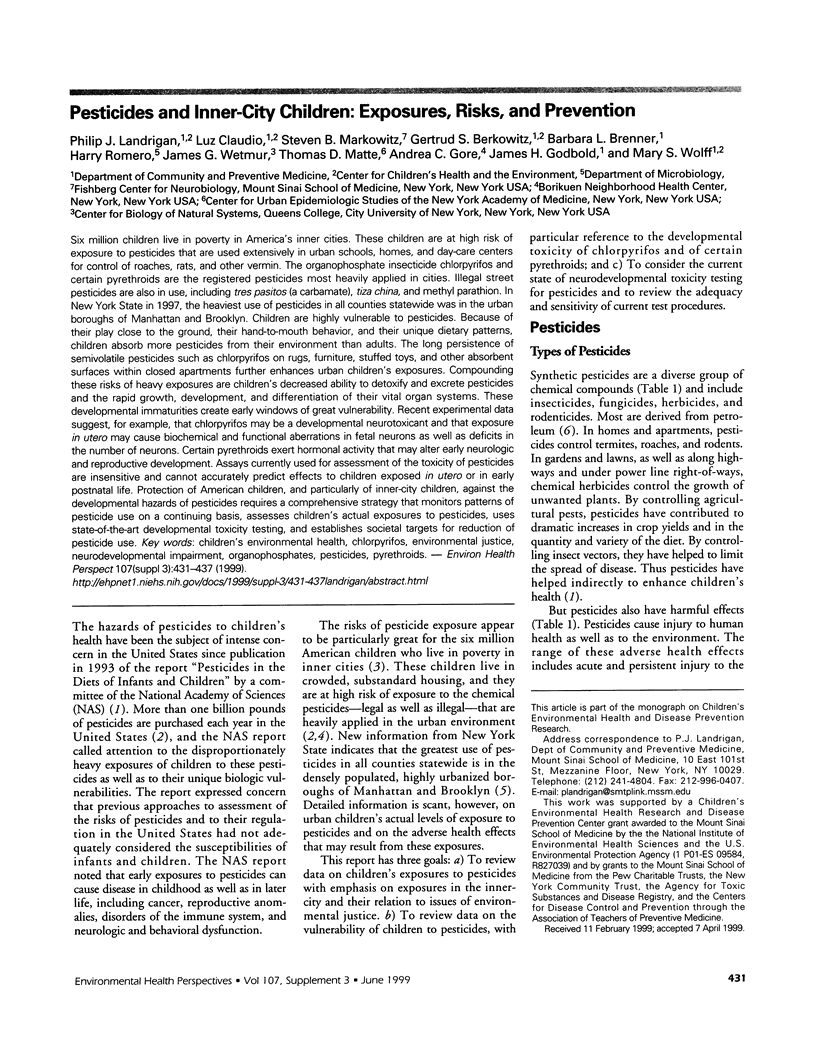
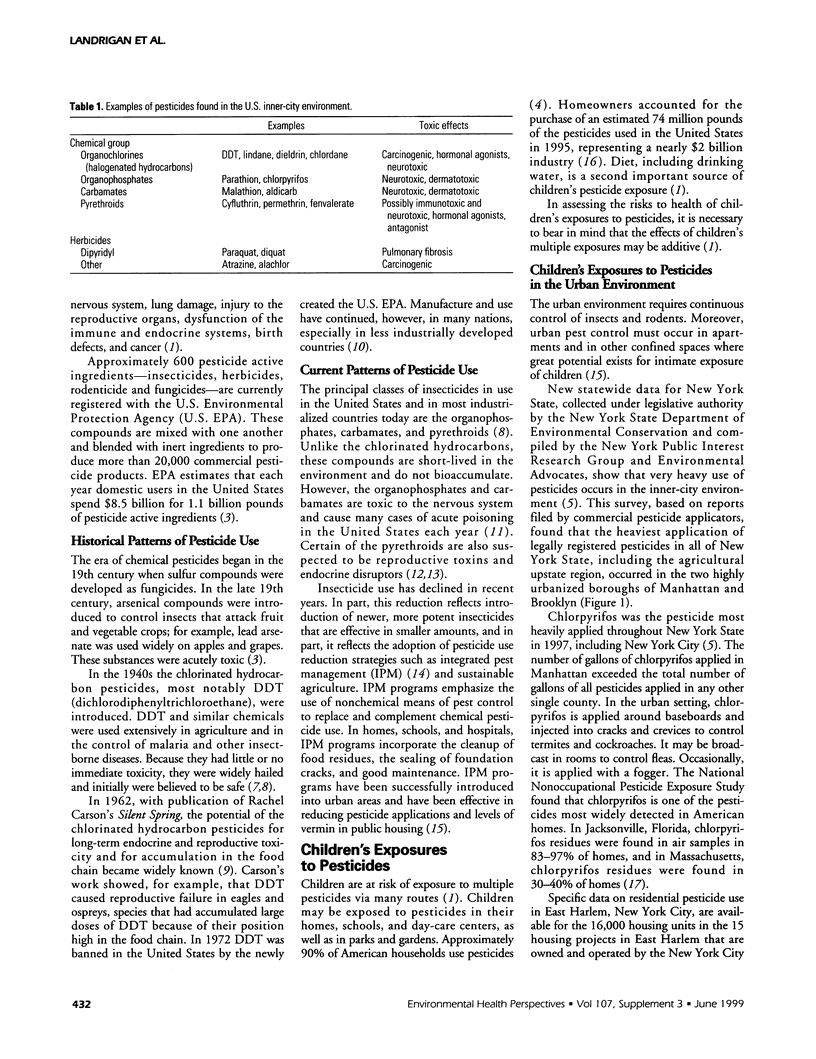
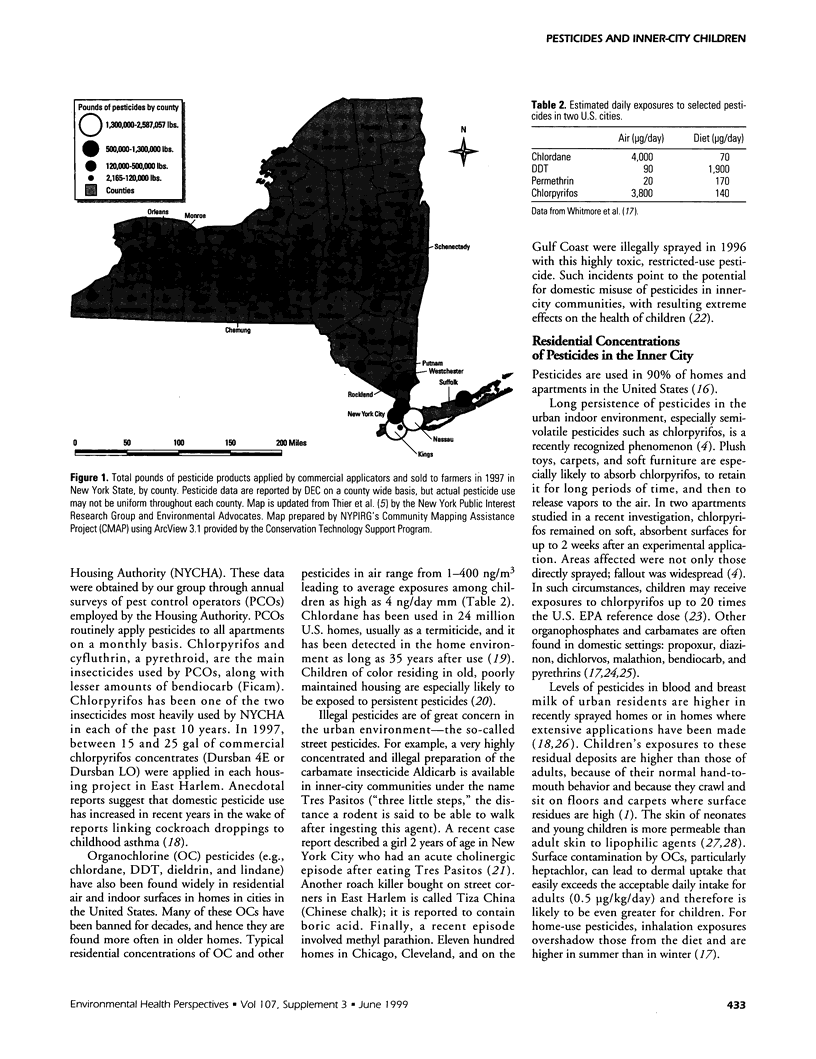
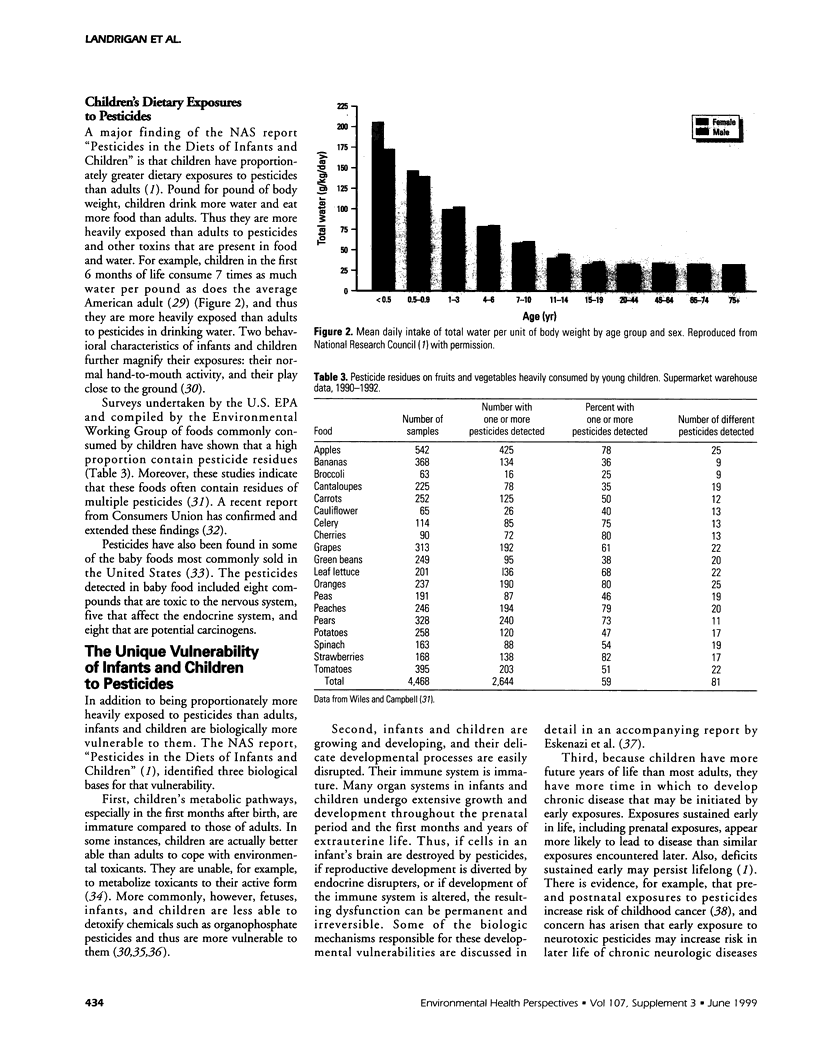
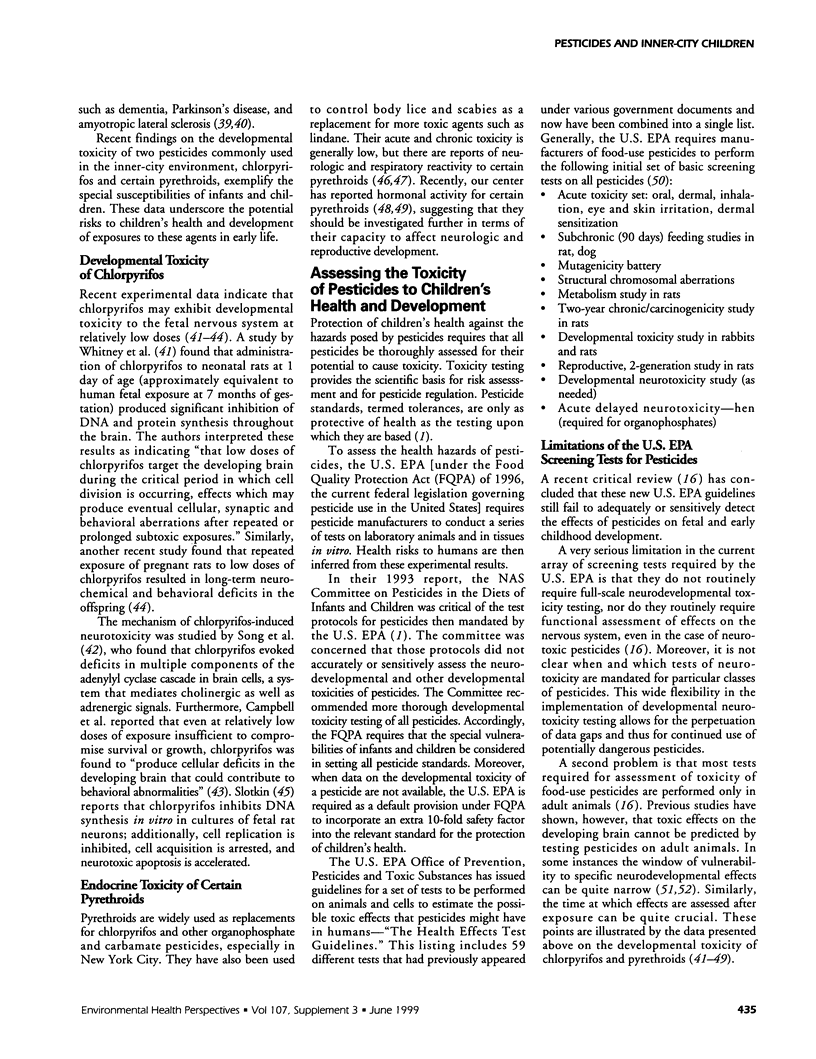
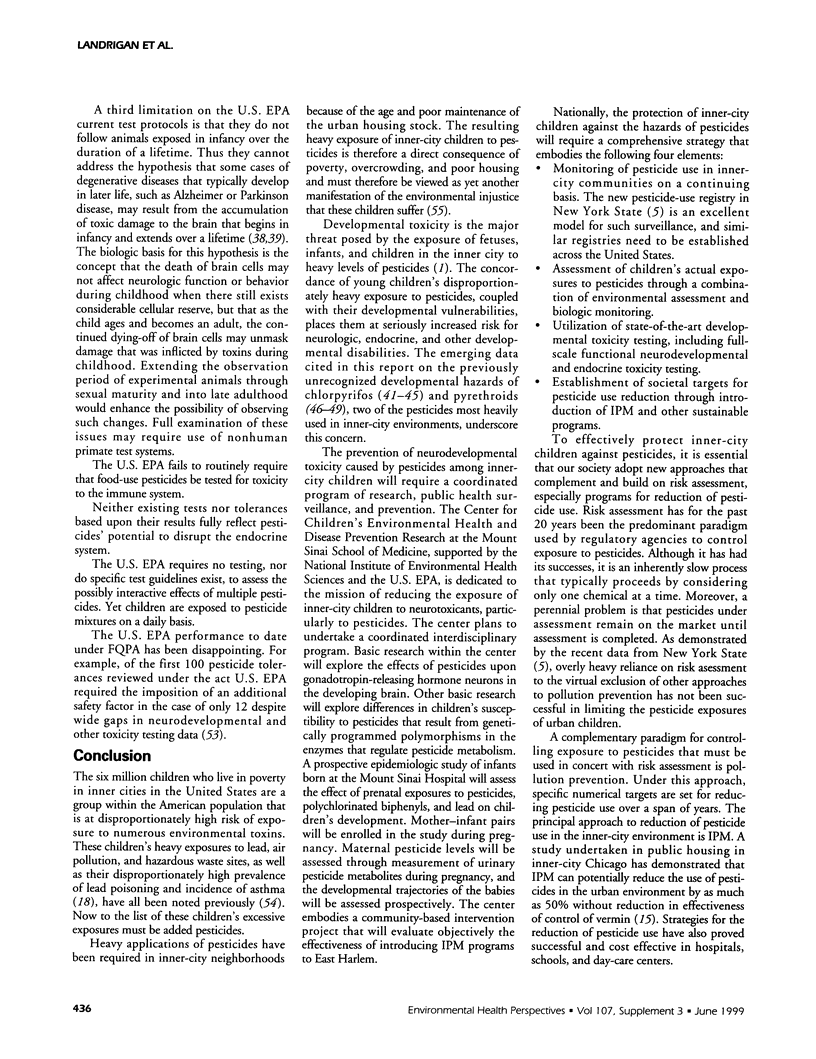
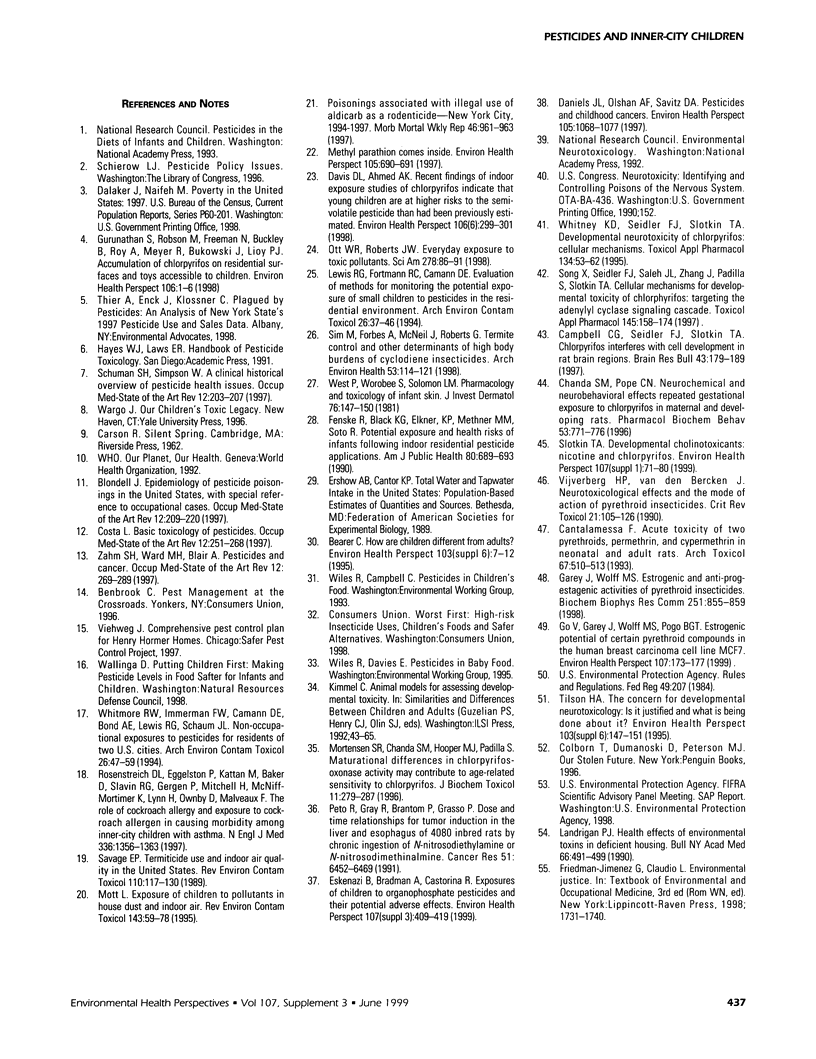
Images in this article
Selected References
These references are in PubMed. This may not be the complete list of references from this article.
- Bearer C. F. How are children different from adults? Environ Health Perspect. 1995 Sep;103 (Suppl 6):7–12. doi: 10.1289/ehp.95103s67. [DOI] [PMC free article] [PubMed] [Google Scholar]
- Blondell J. Epidemiology of pesticide poisonings in the United States, with special reference to occupational cases. Occup Med. 1997 Apr-Jun;12(2):209–220. [PubMed] [Google Scholar]
- Campbell C. G., Seidler F. J., Slotkin T. A. Chlorpyrifos interferes with cell development in rat brain regions. Brain Res Bull. 1997;43(2):179–189. doi: 10.1016/s0361-9230(96)00436-4. [DOI] [PubMed] [Google Scholar]
- Cantalamessa F. Acute toxicity of two pyrethroids, permethrin, and cypermethrin in neonatal and adult rats. Arch Toxicol. 1993;67(7):510–513. doi: 10.1007/BF01969923. [DOI] [PubMed] [Google Scholar]
- Chanda S. M., Pope C. N. Neurochemical and neurobehavioral effects of repeated gestational exposure to chlorpyrifos in maternal and developing rats. Pharmacol Biochem Behav. 1996 Apr;53(4):771–776. doi: 10.1016/0091-3057(95)02105-1. [DOI] [PubMed] [Google Scholar]
- Costa L. G. Basic toxicology of pesticides. Occup Med. 1997 Apr-Jun;12(2):251–268. [PubMed] [Google Scholar]
- Daniels J. L., Olshan A. F., Savitz D. A. Pesticides and childhood cancers. Environ Health Perspect. 1997 Oct;105(10):1068–1077. doi: 10.1289/ehp.971051068. [DOI] [PMC free article] [PubMed] [Google Scholar]
- Davis D. L., Ahmed A. K. Exposures from indoor spraying of chlorpyrifos pose greater health risks to children than currently estimated. Environ Health Perspect. 1998 Jun;106(6):299–301. doi: 10.1289/ehp.98106299. [DOI] [PMC free article] [PubMed] [Google Scholar]
- Eskenazi B., Bradman A., Castorina R. Exposures of children to organophosphate pesticides and their potential adverse health effects. Environ Health Perspect. 1999 Jun;107 (Suppl 3):409–419. doi: 10.1289/ehp.99107s3409. [DOI] [PMC free article] [PubMed] [Google Scholar]
- Fenske R. A., Black K. G., Elkner K. P., Lee C. L., Methner M. M., Soto R. Potential exposure and health risks of infants following indoor residential pesticide applications. Am J Public Health. 1990 Jun;80(6):689–693. doi: 10.2105/ajph.80.6.689. [DOI] [PMC free article] [PubMed] [Google Scholar]
- Garey J., Wolff M. S. Estrogenic and antiprogestagenic activities of pyrethroid insecticides. Biochem Biophys Res Commun. 1998 Oct 29;251(3):855–859. doi: 10.1006/bbrc.1998.9569. [DOI] [PubMed] [Google Scholar]
- Go V., Garey J., Wolff M. S., Pogo B. G. Estrogenic potential of certain pyrethroid compounds in the MCF-7 human breast carcinoma cell line. Environ Health Perspect. 1999 Mar;107(3):173–177. doi: 10.1289/ehp.99107173. [DOI] [PMC free article] [PubMed] [Google Scholar]
- Landrigan P. J. Health effects of environmental toxins in deficient housing. Bull N Y Acad Med. 1990 Sep-Oct;66(5):491–499. [PMC free article] [PubMed] [Google Scholar]
- Lewis R. G., Fortmann R. C., Camann D. E. Evaluation of methods for monitoring the potential exposure of small children to pesticides in the residential environment. Arch Environ Contam Toxicol. 1994 Jan;26(1):37–46. doi: 10.1007/BF00212792. [DOI] [PubMed] [Google Scholar]
- Mortensen S. R., Chanda S. M., Hooper M. J., Padilla S. Maturational differences in chlorpyrifos-oxonase activity may contribute to age-related sensitivity to chlorpyrifos. J Biochem Toxicol. 1996;11(6):279–287. doi: 10.1002/(SICI)1522-7146(1996)11:6<279::AID-JBT3>3.0.CO;2-H. [DOI] [PubMed] [Google Scholar]
- Ott W. R., Roberts J. W. Everyday exposure to toxic pollutants. Sci Am. 1998 Feb;278(2):86–91. doi: 10.1038/scientificamerican0298-86. [DOI] [PubMed] [Google Scholar]
- Peto R., Gray R., Brantom P., Grasso P. Dose and time relationships for tumor induction in the liver and esophagus of 4080 inbred rats by chronic ingestion of N-nitrosodiethylamine or N-nitrosodimethylamine. Cancer Res. 1991 Dec 1;51(23 Pt 2):6452–6469. [PubMed] [Google Scholar]
- Roberts J. W., Dickey P. Exposure of children to pollutants in house dust and indoor air. Rev Environ Contam Toxicol. 1995;143:59–78. doi: 10.1007/978-1-4612-2542-3_3. [DOI] [PubMed] [Google Scholar]
- Rosenstreich D. L., Eggleston P., Kattan M., Baker D., Slavin R. G., Gergen P., Mitchell H., McNiff-Mortimer K., Lynn H., Ownby D. The role of cockroach allergy and exposure to cockroach allergen in causing morbidity among inner-city children with asthma. N Engl J Med. 1997 May 8;336(19):1356–1363. doi: 10.1056/NEJM199705083361904. [DOI] [PubMed] [Google Scholar]
- Schuman S. H., Simpson W. M., Jr A clinical historical overview of pesticide health issues. Occup Med. 1997 Apr-Jun;12(2):203–207. [PubMed] [Google Scholar]
- Sim M., Forbes A., McNeil J., Roberts G. Termite control and other determinants of high body burdens of cyclodiene insecticides. Arch Environ Health. 1998 Mar-Apr;53(2):114–121. doi: 10.1080/00039896.1998.10545972. [DOI] [PubMed] [Google Scholar]
- Slotkin T. A. Developmental cholinotoxicants: nicotine and chlorpyrifos. Environ Health Perspect. 1999 Feb;107 (Suppl 1):71–80. doi: 10.1289/ehp.99107s171. [DOI] [PMC free article] [PubMed] [Google Scholar]
- Song X., Seidler F. J., Saleh J. L., Zhang J., Padilla S., Slotkin T. A. Cellular mechanisms for developmental toxicity of chlorpyrifos: targeting the adenylyl cyclase signaling cascade. Toxicol Appl Pharmacol. 1997 Jul;145(1):158–174. doi: 10.1006/taap.1997.8171. [DOI] [PubMed] [Google Scholar]
- Tilson H. A. The concern for developmental neurotoxicology: is it justified and what is being done about it? Environ Health Perspect. 1995 Sep;103 (Suppl 6):147–151. doi: 10.1289/ehp.95103s6147. [DOI] [PMC free article] [PubMed] [Google Scholar]
- Vijverberg H. P., van den Bercken J. Neurotoxicological effects and the mode of action of pyrethroid insecticides. Crit Rev Toxicol. 1990;21(2):105–126. doi: 10.3109/10408449009089875. [DOI] [PubMed] [Google Scholar]
- West D. P., Worobec S., Solomon L. M. Pharmacology and toxicology of infant skin. J Invest Dermatol. 1981 Mar;76(3):147–150. doi: 10.1111/1523-1747.ep12525553. [DOI] [PubMed] [Google Scholar]
- Whitemore R. W., Immerman F. W., Camann D. E., Bond A. E., Lewis R. G., Schaum J. L. Non-occupational exposures to pesticides for residents of two U.S. cities. Arch Environ Contam Toxicol. 1994 Jan;26(1):47–59. doi: 10.1007/BF00212793. [DOI] [PubMed] [Google Scholar]
- Whitney K. D., Seidler F. J., Slotkin T. A. Developmental neurotoxicity of chlorpyrifos: cellular mechanisms. Toxicol Appl Pharmacol. 1995 Sep;134(1):53–62. doi: 10.1006/taap.1995.1168. [DOI] [PubMed] [Google Scholar]
- Zahm S. H., Ward M. H., Blair A. Pesticides and cancer. Occup Med. 1997 Apr-Jun;12(2):269–289. [PubMed] [Google Scholar]




